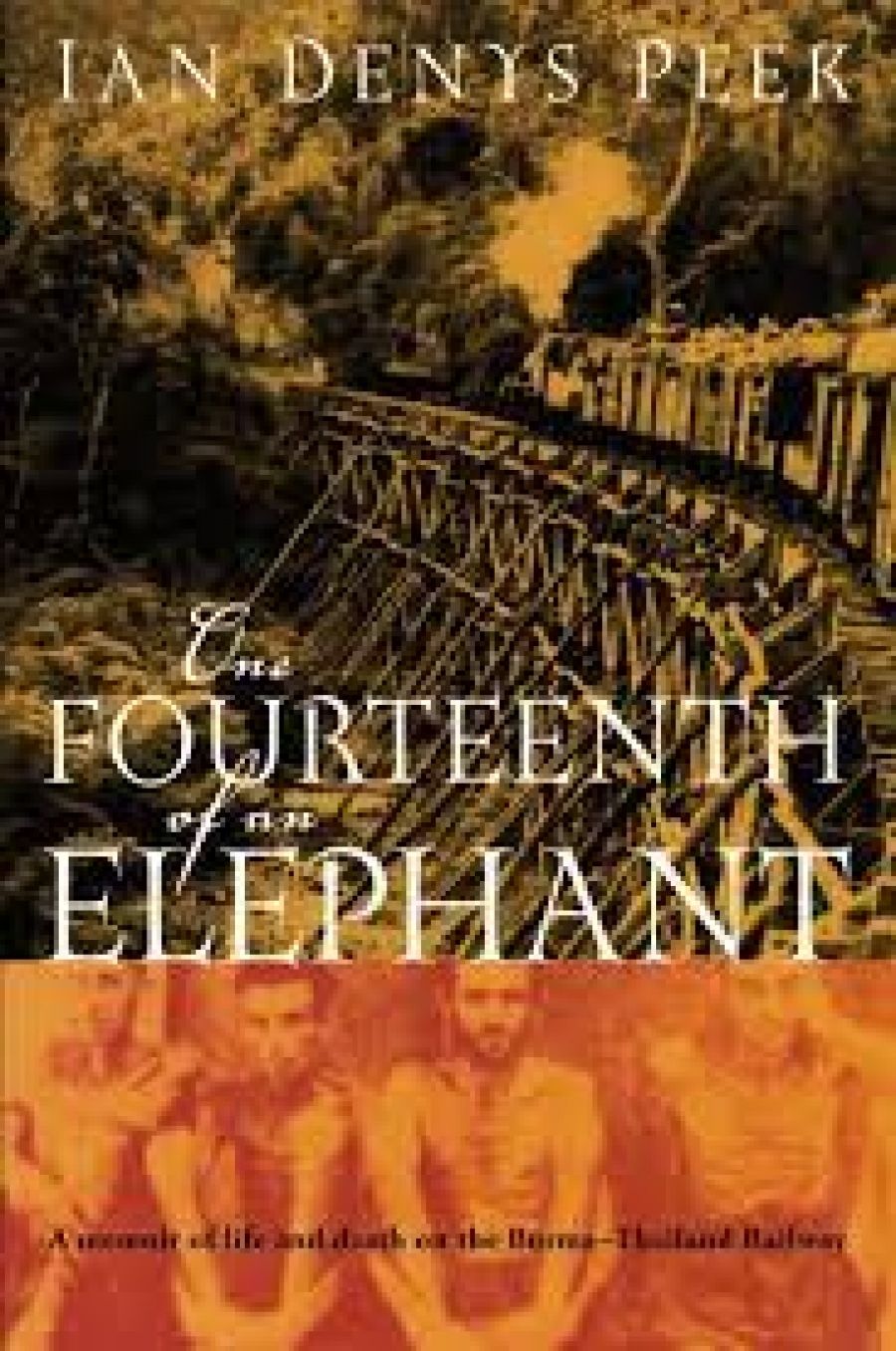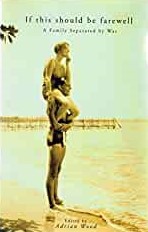
- Free Article: No
- Contents Category: War
- Review Article: Yes
- Online Only: No
- Custom Highlight Text:
These two unusual books reflect on aspects of the prisoner-of-war experience in Singapore, Thailand and Burma during World War II that have not been much canvassed in Australia. One Fourteenth of an Elephant, Ian Denys Peek’s sometimes irascible ‘memoir of life and death on the Burma-Thailand Railway’, relates the experiences of a member of the Singapore Volunteer Armoured Car Company. Peek was British and had grown up in Shanghai, but was not taken into captivity there as was novelist J.G. Ballard (who recalled the experience in Empire of the Sun). Peek and his brother Ron were at the fall of Singapore. Soon afterwards began their movements between a series of hospital and labour camps along the railway. Peek’s story – his first book, published sixty years after his capture and told in the first person – gives a British perspective on a fate that he shared with thousands of Australians.
- Book 1 Title: One Fourteenth of an Elephant
- Book 1 Subtitle: A memoir of life and death on the Burma-Thailand Railway
- Book 1 Biblio: Macmillan, $30 pb, 518 pp
- Book 2 Title: If This Should Be Farewell
- Book 2 Subtitle: A family separated by war
- Book 2 Biblio: FACP, $24.95 pb, 333 pp
- Book 2 Cover (800 x 1200):

So, too, does If This Should Be Farewell: A Family Separated by War. Edited by Adrian Wood, this is a compilation from the letters of his grandmother Mary (who escaped Kuala Lumpur, then Singapore, to arrive in initial dismay at Perth) and his grandfather Ernest Hodgkin (a medical entomologist who was one of 3,000 civilian internees at Changi and Sime Road gaols in Singapore). Artfully interwoven, they provide a distinctive perspective on separation, anxiety, incomprehension, and hope, as the torn family, and the parents in particular, tried to maintain contact. The Hodgkins were English Quakers, who had welcomed the chance to work in Malaya, and quickly had four children. Australia would become their home, as it would for Peek.
In his Author’s Note, Peek insists that: ‘The events described are just as I remembered them. They were not forgotten and dredged up after fifty years; they have been part of my life ever since they happened.’ Whereas Wood had original documents to furnish his book (samples of which are reproduced), it is not clear whether Peek worked from notes made at the time, or from a sustained and long-delayed series of recollections. Each narrative has a freshness and bluntness that illuminate events beyond experience or understanding as they in fact occurred.
Peek refers – as does Ernest Hodgkin, although less aggressively – to ‘Nips’ and ‘Asiatics’, and to ‘Siam’ as well, because that was how the country was ‘known to us who lived in that part of the world’. His anger towards ‘thick-brained Nips’ is still urgent and unforgiving. This intensifies when Peek recalls ‘the stone-faced Kempetai … These degraded troglodyte monsters, the Japanese army police, chill the air around them by their mere presence.’ For Hodgkin, who endured hunger and anguish, but no physical punishment or forced labour (in gaol he continued his research into malaria), the worst day of his confinement was the ‘double tenth’, 10 October 1943, when the Kempetai came calling. He writes, ‘the Gestapo ransacked the camp’. There is no down-right loathing in his diary, as there is in Peek’s memoir. Hodgkin’s harshest words are reserved for the Sikh guards, ‘noisy, empty-headed boors’, ex-prison warders and police. Neither author reaches beyond his imprisonment to achieve what the Australian sailor Ray Parkin called ‘tolerance of intolerance’ in his outstanding POW trilogy.
While Hodgkin never left Singapore (although he was able to leave gaol occasionally for swims at the beach), Peek was soon sent up the line to Kanchanaburi for work on the railway. (A few of the many thousands of those who died in its construction are buried at this curious site, which also hosts the JEATH memorial that lumps by acronym the Japanese aggressor and its Thai collaborator with English, Australian and Dutch prisoners.) The extremities of life in the camp energise Peek’s prose. There are hallucinatory moments: the air above a river fills with a ‘great white cloud of butterflies’; the voice of an old friend spectrally issues from a graveyard. Brother Ron hears it, too. Other moments are altogether corporeal: notably the effects of repeated attacks of beri beri, and the insult that illness deals one’s testicles and shit.
One Fourteenth of an Elephant (the reference is to the men’s work capacity) is dedicated to ‘those thousands of friends and unknown mates’ who died on the railway. It is marked by contempt not only for the Japanese, but for officers (medical officers, especially a large Australian, excepted) who took little part in the work and showed scant sympathy for the suffering of the soldiers nominally under their com-mand. Peek is also infuriated by the obtuseness of those writing in freedom from home: ‘weak beer hardly worth drinking, gin and whisky almost unobtainable … Cigarettes rationed, eggs rare, the meat ration even smaller – dear me, isn’t life tough at home?’ The letters of Mary Hodgkin to her husband and to his parents in England are only partly written in complaint. As with her husband, resolution was all.
If This Should Be Farewell has a foreword by World War II veteran and author T.A.G. Hungerford (Knockabout in a Slouch Hat), in which he comments on the plight of Ernest Hodgkin: ‘separated from his family in a foreign land, in a situation which from time to time he must have feared in his heart could only end in his own death and those of thousands of his compatriots.’ Yet there was solace: letters did arrive and, because of the professional background of many of the internees, Changi Gaol fostered ‘a culture of learning and enquiry’. Hodgkin, like Peek, writes a plain, direct prose. His eye is attentive; self-pity is proscribed. Sometimes, like Peek, he is disconcerted by the incompleteness of what he hears from home, by changes of circumstances taken for granted. Mary finds work as a teacher. With two bequests from a dead uncle, she buys a house. Reasonably, Ernest asks: ‘You are teaching – where? What? You have bought a house and are a landed proprietor – how? Why?’
Mary coped with fears about bringing up children in Australia (‘the accent they will collect is pretty awful’) and with the servant problem (‘Our housekeeper isn’t very satisfactory’). She also has to cope with her husband’s return, for he is ‘a wee bit vague and will not take responsibility’. That one line hints at volumes that might be written about readjustment to life after captivity. It would be idle not to mention the pleasures of what have become anachronisms. Thus Mary tells her husband that their two eldest boys ‘are shooting up’. In turn, he notes ‘an influx of Fannys’ to the gaol. Female army nurses are all that Mary has to beware.
Most impressively, Wood shows, by the juxtaposition of his materials, how present hardship was borne at the same time as the elements of a future life were being prepared. Both Mary and Ernest went on to academic careers at the University of Western Australia. Each of these fine books is an account of quiet victories – of survival, of course, but more important, of self-mastery.


Comments powered by CComment